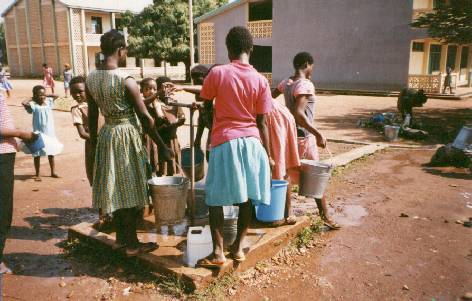| <=
|
 |
=>
|
| <=
|
 |
=>
|
Domestic chores account for a significant proportion of all boarders' time after classes. As you can see from this picture, many schools have no piped water and rely on a number of deep boreholes to provide water for everything from cooking and cleaning to bathing and laundry. At Law sec there were three boreholes to supply water for the 800 campus inhabitants, although often only two would be serviceable at any one time. The school originally had a mechanically powered pumping system and storage facility, but the pump became unserviceable years ago and with it any means by which to store water. The result is that water must be hand pumped on demand. A single bucket of water, which contains approximately 15 litres of water, takes about 2 minutes to draw and requires about 10 or 15 full pump handle strokes, depending on the water lever below. Most students draw about two buckets for themselves daily, but would also be required to provide one or two more buckets for the school kitchens, science lab and masters. When water levels drop, students can queue for upto an hour for a single bucket. In schools without powered pumping and storage, water collecting can waste many hours of the day.
During the second term, the rainy season arrives around May. From this point until the end of the term in June or July, students are also expected to work on the school farm which produces maize, other cereal crops and groundnuts (peanuts) for storage and use during the following terms. After the initial mechanised ploughing of the fields, sowing, weeding and harvesting are all done by hand, again occupying large amounts of the students time. It is a requirement for students to bring hoes and cutlasses from home to enable them to work whilst boarding.